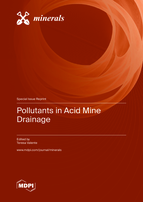Pollutants in Acid Mine Drainage
A special issue of Minerals (ISSN 2075-163X). This special issue belongs to the section "Environmental Mineralogy and Biogeochemistry".
Deadline for manuscript submissions: closed (27 November 2020) | Viewed by 70733
Special Issue Editor
Interests: mine waters and mine wastes; acid mine drainage and acid rock drainage; environmental mineralogy; biomonitoring; environmental monitoring and modeling of mine sites
Special Issues, Collections and Topics in MDPI journals
Special Issue Information
Dear Colleagues,
Acid mine drainage (AMD) is one of the major environmental consequences of mining activity that often causes complete degradation of the ecosystems during and or after mine closure. AMD is a peculiar focus of research because it involves assessing the presence and reactivity of various pollutants, which may affect the subsequent analytical processes of characterization.
The systems affected by AMD have high heterogeneity and generate samples with complex matrices. Moreover, frequently, AMD generates high amounts of colloids, most in the nanoscale dimensions. Further, acid drainage represents peculiar ecosystems, dominated by acidophilic organisms involved in complex interactions with influence on the migration and fate of pollutants. In addition, evolution of AMD promotes the development of AMD-precipitates that control the equilibrium and evolution conditions. This Special Issue aims to cover the diversity of research items associated with the complexity of AMD, such as the source and nature of the pollutants, speciation, migration, fate, and toxicity, including that of nanoparticles, and the biogeochemistry and mineralogy of the AMD systems. Papers providing examples of the methodological challenges and with novel tools for monitoring and characterization of AMD are welcome.
Dr. Teresa Valente
Guest Editor
Manuscript Submission Information
Manuscripts should be submitted online at www.mdpi.com by registering and logging in to this website. Once you are registered, click here to go to the submission form. Manuscripts can be submitted until the deadline. All submissions that pass pre-check are peer-reviewed. Accepted papers will be published continuously in the journal (as soon as accepted) and will be listed together on the special issue website. Research articles, review articles as well as short communications are invited. For planned papers, a title and short abstract (about 100 words) can be sent to the Editorial Office for announcement on this website.
Submitted manuscripts should not have been published previously, nor be under consideration for publication elsewhere (except conference proceedings papers). All manuscripts are thoroughly refereed through a single-blind peer-review process. A guide for authors and other relevant information for submission of manuscripts is available on the Instructions for Authors page. Minerals is an international peer-reviewed open access monthly journal published by MDPI.
Please visit the Instructions for Authors page before submitting a manuscript. The Article Processing Charge (APC) for publication in this open access journal is 2400 CHF (Swiss Francs). Submitted papers should be well formatted and use good English. Authors may use MDPI's English editing service prior to publication or during author revisions.
Keywords
- Acidity
- Stress conditions
- AMD-precipitates
- Monitoring tools
- Transport and fate
- Nanopollutants






